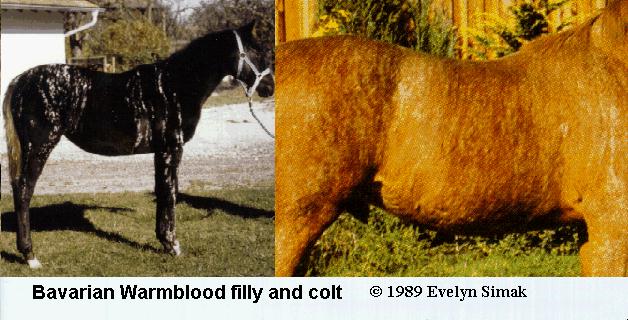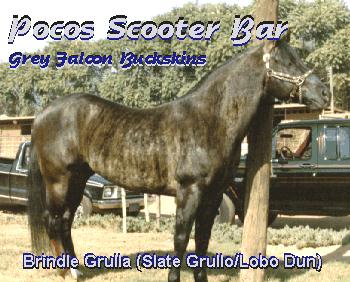

In the book Horse Color, 1983, by D. Phillip Sponenberg and Bonnie V. Beaver, on page 29 under Primitive Marks, there is only a brief reference; "Very rarely a horse will be extensively striped, almost to the extent of resembling a zebra. Such horses are known to occur in Siberia, Scandinavia, and Argentina". However, in D. Phillip Sponenberg's latest book from 1996, Equine Color Genetics, on page 45, he has a more extensive mention of Brindle. He describes brindle as "vertical black (or its derivatives) stripes on any background color... Brindle seems to require sooty black countershading for its expression, and reorganizes sootiness into vertical stripes instead of a more uniform sprinkling of hairs... Brindle has been seen as a rare variant in a variety of countries and horse breeds, but is so rare that generalities about its breed occurrence or genetic control are impossible to state. It is dominant in both dogs and cattle, which are other mammels in which brindling occurs." In the color plate on page 107, Fig.8.47, the horse Brenda Batty Atty is used as an example of the brindle pattern. Also of interest is Fig.8.65 and 8.66 on page 113, which show two Bavarian Warmbloods which have roan and white striping. He says "Most horses with odd white striping...are the result of chance errors that occur in the development of the pigment system of the embryo. These horses will not reproduce these stripes... White or roan striping is probably biologically different than brindling, which is black striping, even though the patterns appear superficially similar." Below are different pictures, but of the same two Bavarian Warmbloods.

In 1988, Mary Jagow of Silver Cliff, Colorado, began organizing the International Striped Horse Association in order to collect information of various striping patterns. She had noticed four basic types of striping: Dun Factor Striping, Bay Striping (renamed countershading striping), Roan Striping, and Brindle. Yearly articles were published in the Western Horseman Breed Issue, each year featuring one of the different forms of striping she was working on. In the Spring 1993 issue of 4-Beat Magazine, vol.3-no.1,pp 30-35, the original article "Striping and Camouflage in Horses" by J. Sharon Batteate was published, detailing some background information on protective coloration before proceeding into the various forms of striping the ISHA was working on. The article was revised in February 1997, and posted on a webpage at ../../stripedhos/striped-article/striped.htm

Another interesting reference which may prove related to the brindle pattern, is in the 1971 book Genetics of the Horse by William E. Jones and Ralph Bogart. On pages 302,304,309,334 are references to the Blo locus. On page 334 they say, "Blo Locus - An allelle causing a hair abnormality resulting in many dark pigmented spots over the body". On page 308 they reference "Searle (1969) cites evidence that among some spotted animals, such as the tabby cat, darker spots appear because of a difference in local hair type." On page 309 - "An entirely different type of spotting is also found in some Appaloosas which is similar to the blotch gene of the mouse. Actually, the gene affects the development of the hairs in many localized spots over the body. The abnormal hair seems to produce a different chemical environment for the melanocytes associated with it so that somehow the color phenotype of the hair is changed. Often in Appaloosas, blotch is associated with an allele of the SI locus, which produces small white flecks or spots." I feel the difference in hair type and coat texturing found in brindle horses may turn out to be related to this Blo pattern documented in Appaloosas. Either Brindle influenced by one of the Appaloosa spotting genes, could be broken up into smaller spots producing the described pattern, or the gene causing the brindle pattern and the gene causing the Blo pattern are closely related.
According to The Coat Colors of Mice, 1979, by Willys K. Silvers, in mice there are at least 6 different locus which produce striping patterns (usually called mottling in mice). At the "A" (Agouti) locus, striping has appeared in viable yellow, mottled agouti, and agouti suppressor mice. At the "C" locus, striping has appeared in chinchilla mottled mice. At the "P" locus, striping has appeared in pink eyed mottled and p unstable mice. Striping has also appeared in mice at the "Silver" locus, and "Pearl" locus. Striping also appears at the "Mo" locus (responsible for Mottled, Blotchy, Dappled, Brindle, and Tortoiseshell patterns), and the nearby "Ta"(Tabby) locus. Whether any of these genes may be similar and account for striping patterns in horses remains to be determined.
In 1994 Mrs Pilar Massaguer of Spain contacted me regarding an article she was doing for El Caballo, Nov 1994, no.137, pg.55-58. She asked for a picture of the mare Brenda Batty Atty, as an example of the "gateado barcino" color for her article on "El Bayo - mucho mas que una simple raza de color", about buckskin, dun, and grulla colors.
In the Jan/Feb 1998 issue of The Brayer an article on Stripes Aren't Just For Zebras! featured a picture of a brindle mule. This article has been edited for the Yipes! Stripes!website and does not include all the original photos in the article. We recommend you email [email protected] or contact (940) 382-6845 The Brayer, 2901 N. Elm St, Denton, TX 76201 - for a reprint of this article. This article was originally published in The Brayer (vol.31 no.1, Jan/Feb '98, pp 97-99). The website for the American Donkey and Mule Society is http://www.fuzzywunkle.net/adms.
I am interested in locating other references to the "brindle" or "brindle dun" pattern. If you know of any, please contact me.
Volume 2, number 4. Written information was last updated © May 1, 1998. We will update the written information approximately once a month - however, because Brindle Horses are so rare, we may not be able to update the photos in the slideshow that often. When returning to this site, remember to select the refresh or reload icon from your internet explorer tool bar at the top of the screen, so your screen will reload the latest information. The address of this web site is http://www.geocities.com/sbatteate
You may e-mail me at [email protected] Click here to e-mail me!
You may also contact me: (209) 477-1536, J. Sharon Batteate, PO Box 8535, Stockton, CA 95208 USA
Click this type for a picture of a Brindle Horse with contact information you can print.